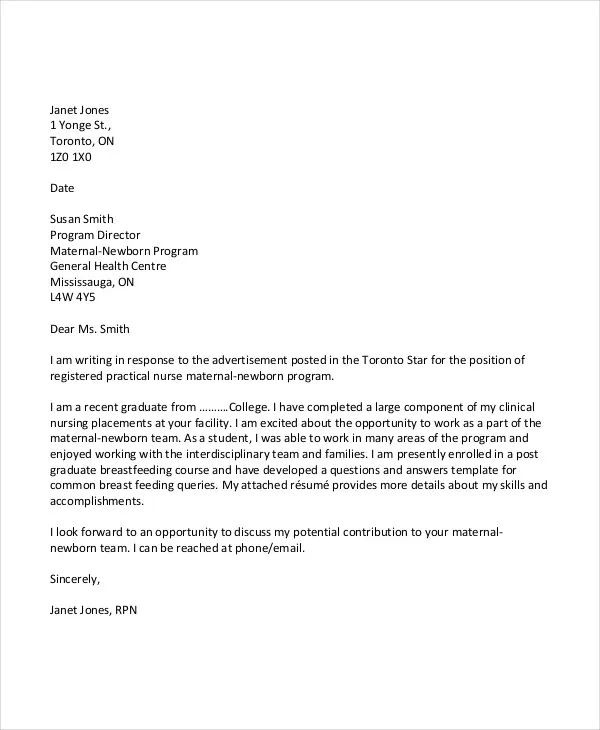The Importance of a Cover Letter Email
In today’s digital age, a cover letter email is often the first impression you make on a potential employer. It’s a crucial component of your job application, serving as a personalized introduction that can significantly impact your chances of landing an interview. A well-crafted cover letter email demonstrates professionalism, attention to detail, and a genuine interest in the position. It goes beyond simply attaching your resume; it provides context, highlights your key skills, and makes a compelling case for why you’re the ideal candidate. Neglecting this aspect could mean missing out on valuable opportunities. Remember, the goal is not just to submit your resume but to persuade the hiring manager to take a closer look at you. A cover letter email is your primary tool to achieve this.
Why Cover Letter Emails Matter
Cover letter emails matter because they give you an opportunity to showcase your personality and communication skills. They allow you to connect with the hiring manager on a more personal level. This personal touch can make all the difference. They also help tailor your application to the specific job requirements. By highlighting the skills and experiences most relevant to the role, you demonstrate your understanding of the position and your ability to contribute to the company’s success. Moreover, cover letter emails provide a valuable opportunity to elaborate on your resume and provide context to your achievements. This is where you can provide more detailed information to show the hiring manager what sets you apart from the competition and gives them more information on your career path.
Cover Letter Email vs. Traditional Cover Letter
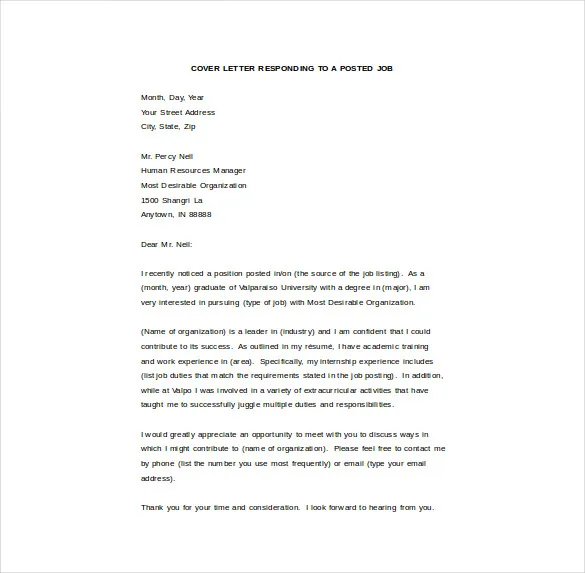
While a traditional cover letter is a formal document often formatted as a separate attachment, a cover letter email serves as the introduction, the ‘cover letter’ itself, and typically includes a concise summary of your qualifications and your interest in the job. The main difference lies in the context and delivery. The cover letter email should be concise and targeted to the hiring manager’s attention from the first line. Traditional cover letters can be longer, as they allow you to showcase your qualifications, experiences, and accomplishments with detailed explanations of your accomplishments. In an email, you’ll want to be more direct and focus on the most essential information. Both serve the same purpose: to introduce you and your skills to a potential employer. However, the email format prioritizes immediate impact, whereas the traditional version allows for more extensive detail.
Top 5 Tips to Get Hired
Tip 1 Make it Personal
Personalization is key to making a strong impression. A generic email, identical to hundreds of others, is unlikely to capture the hiring manager’s attention. Demonstrate that you’ve researched the company and the specific role. Use the hiring manager’s name if possible, and address the company culture. This shows initiative and a genuine interest in the opportunity. The goal is to show that you’re not just applying for any job, but you have a desire to work at this company in particular. Make sure the email highlights the company’s values and how your skills can benefit them.
Customize the Email for Each Job
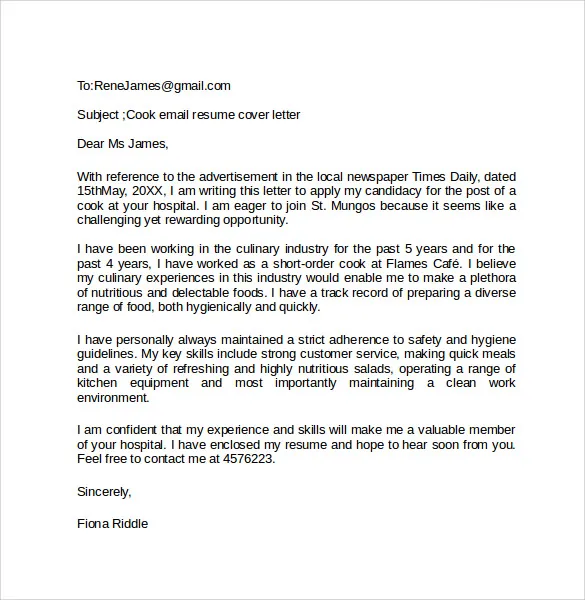
Tailoring your email to each job application is essential. Avoid using a generic template. Instead, carefully review the job description and customize your email to address the specific requirements and keywords mentioned. Highlight the skills and experiences most relevant to the role, and explain how your qualifications align with the company’s needs. By tailoring the message to each job, you show the hiring manager that you’ve taken the time to understand the role and are genuinely interested in it. The more effort you put in at this stage, the higher your chances of success.
Highlight Relevant Skills
Identify the key skills and qualifications that the employer is seeking and showcase how you possess them. Use keywords from the job description and provide concrete examples to demonstrate your abilities. Don’t just list your skills; provide context and show how you’ve used them to achieve results in previous roles. This will help you stand out from other applicants and quickly prove your worth. When you highlight your most relevant skills and experience, the hiring manager can quickly see what you can bring to the company.
Tip 2 Keep it Concise and Focused
Hiring managers are busy, so your cover letter email needs to be brief and to the point. Avoid rambling or including unnecessary details. Keep it focused on the most important information: why you’re interested in the job and what you can offer the company. Your email should be a clear and concise summary of your qualifications, designed to capture the hiring manager’s attention and encourage them to read your resume. Always remember that it is a way to make them want to learn more about you. A good guideline is to keep your email to around four or five short paragraphs.
Focus on Key Achievements
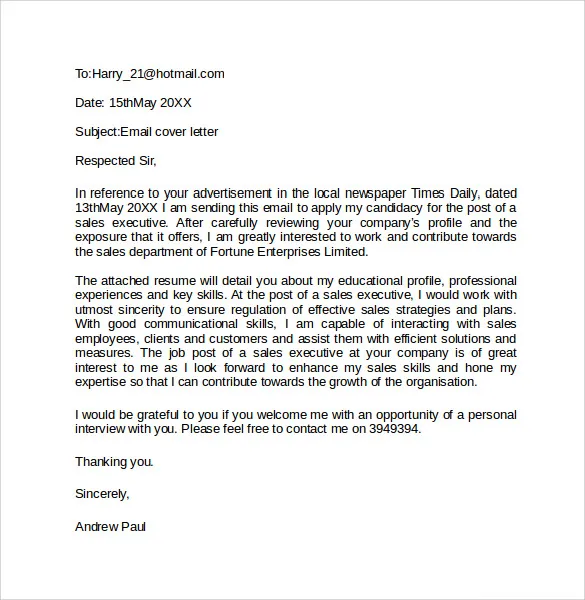
Instead of listing your responsibilities, focus on your key accomplishments. Highlight the results you achieved in previous roles, such as increased sales, improved efficiency, or successful project completion. Provide specific examples to demonstrate your impact and quantify your achievements whenever possible. This is what sets you apart and shows your value to the company. The focus should always be on the outcomes of your actions, not just the actions themselves. This approach shows that you are results-oriented and can make a difference in the company.
Use a Clear and Professional Tone
Maintain a professional tone throughout your email. Use clear, concise language and avoid slang or informal expressions. Proofread your email carefully for any grammatical errors or typos. Your writing style reflects your attention to detail and professionalism. Choose a professional font and format your email in an easy-to-read way. Maintain a respectful and courteous tone, and remember that you are communicating with a potential employer. The goal is to present yourself as a polished and professional candidate.
Tip 3 Show, Don’t Just Tell
Instead of simply stating that you have certain skills or qualifications, provide concrete examples to demonstrate your abilities. Use the STAR method (Situation, Task, Action, Result) to structure your examples and showcase your accomplishments. By providing specific details, you make your claims more credible and memorable. Remember that the hiring manager wants to see proof of your skills, not just a list of them. Focus on telling stories, not just stating facts.
Provide Specific Examples
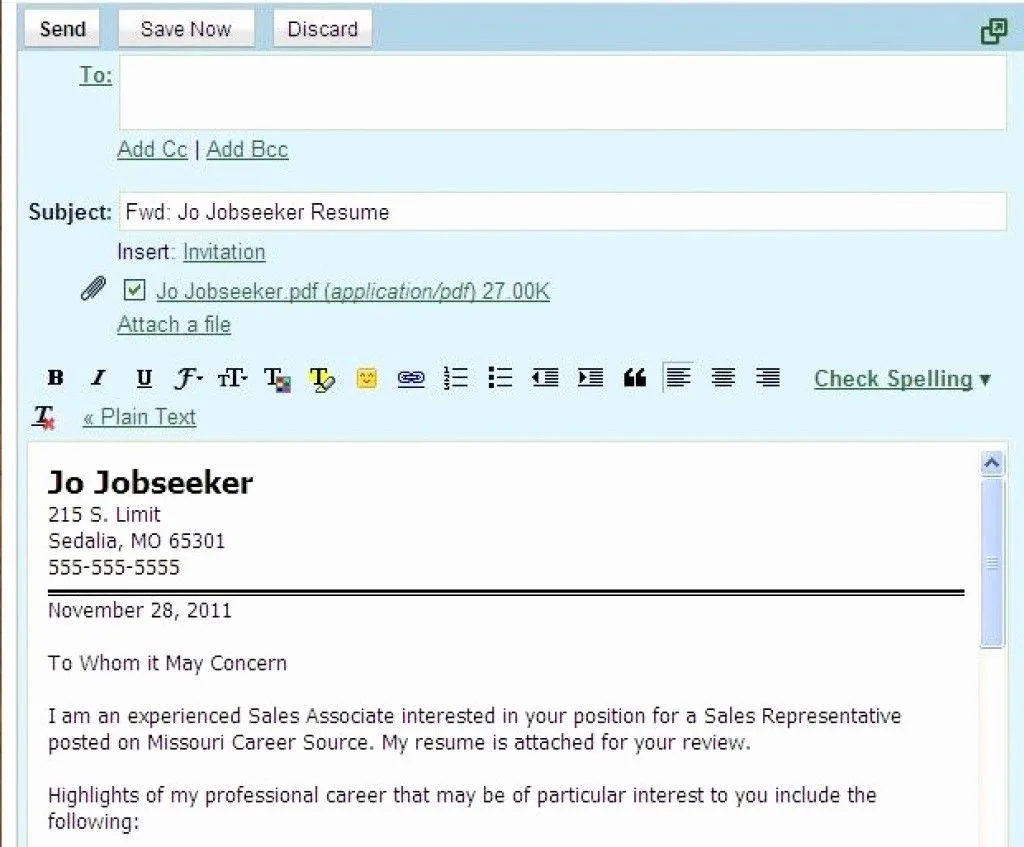
Offer specific examples of how you’ve used your skills to achieve positive results in previous roles. For example, if you claim to have strong communication skills, provide an instance where you successfully communicated a complex idea to a team, or resolved a conflict through effective communication. The more detailed and specific your examples are, the more impactful your cover letter email will be. Specific examples will show how your skills can translate to the new job and how you were successful in your past positions.
Quantify Your Accomplishments
Whenever possible, quantify your accomplishments to demonstrate your impact. Use numbers, percentages, or other metrics to show how you’ve improved performance, increased efficiency, or achieved specific goals. Quantifiable achievements are more compelling and memorable. For example, instead of saying ‘Improved customer satisfaction,’ say ‘Increased customer satisfaction by 15%.’ This level of detail will make a bigger impression and give the hiring manager a clearer understanding of your value. These numbers will demonstrate that you are results-oriented and capable of making a difference.
Tip 4 Optimize for Applicant Tracking Systems (ATS)
Many companies use Applicant Tracking Systems (ATS) to screen applications. These systems scan your cover letter email and resume for keywords and phrases. To ensure your application makes it through, you need to optimize your email. This means using keywords from the job description and formatting your email correctly. By understanding how ATS systems work, you can significantly increase your chances of getting noticed.
Use Relevant Keywords
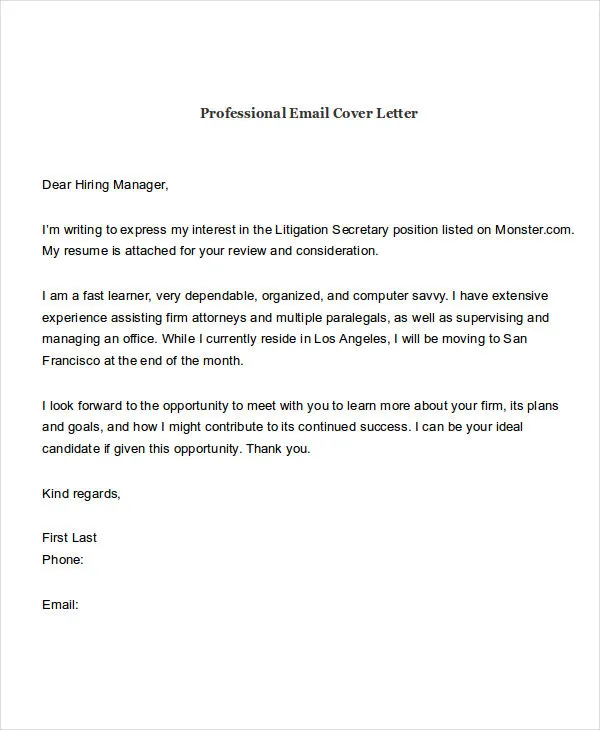
Carefully review the job description and identify the keywords and phrases that the employer uses to describe the role. Incorporate these keywords naturally into your cover letter email and resume. This will help ensure that your application gets past the initial screening process and reaches the hiring manager. Be careful not to overuse keywords, as this can make your email sound unnatural or forced. The goal is to use the right keywords without sounding like you are keyword stuffing your email.
Format the Email Correctly
Proper formatting is crucial for both readability and ATS compatibility. Use a clear and professional font, such as Arial or Times New Roman. Use bullet points or numbered lists to break up large blocks of text and make it easier to scan. Avoid using complex formatting, as it can confuse ATS systems. Keep the email clean and simple, and make sure your contact information is easy to find. Proper formatting will improve your chances of passing the ATS and making a great first impression.
Tip 5 Include a Strong Call to Action
A call to action (CTA) encourages the hiring manager to take the next step, such as reviewing your resume or scheduling an interview. Include a clear and concise CTA at the end of your email, letting them know what action you’d like them to take. A strong CTA can significantly increase your chances of getting a response. The CTA should be clear and easy to understand and should guide the hiring manager to the next stage of the hiring process.
Encourage a Response
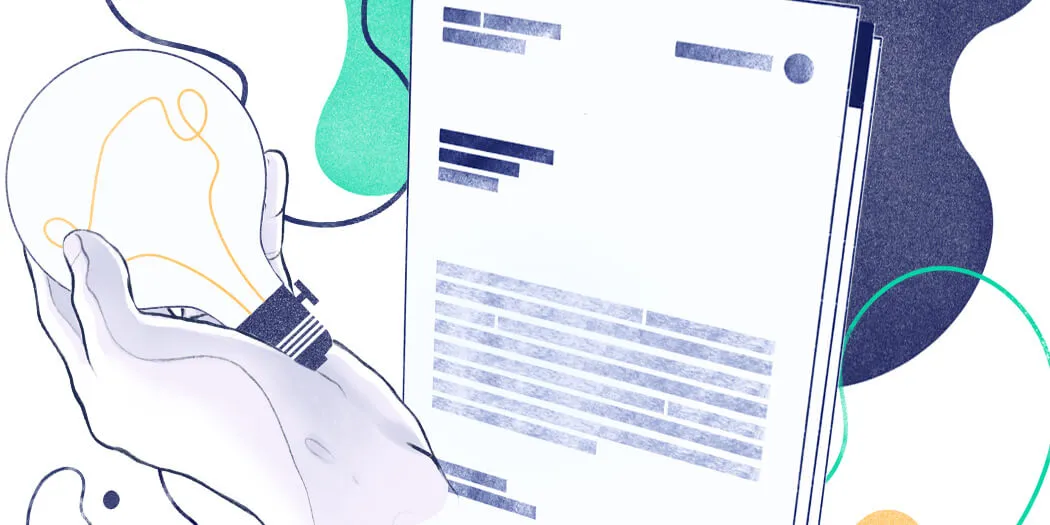
Make it easy for the hiring manager to respond. Include a direct request for an interview or follow-up. For example, you could write ‘I am eager to discuss my qualifications further and would welcome the opportunity to speak with you.’ This shows initiative and demonstrates your enthusiasm for the role. The goal is to make the hiring manager’s job as easy as possible by guiding them towards your resume or inviting them to contact you for an interview.
Express Your Enthusiasm
Show your enthusiasm for the job and the company. Let the hiring manager know why you’re interested in the role and what excites you about the opportunity. This can be as simple as stating your excitement about the company’s culture. Demonstrating your enthusiasm can make a positive impression and distinguish you from other candidates. Your enthusiasm is infectious and can make you stand out from other applicants. This enthusiasm can have a significant impact on the hiring manager.
Email Formatting and Structure
Subject Line Best Practices
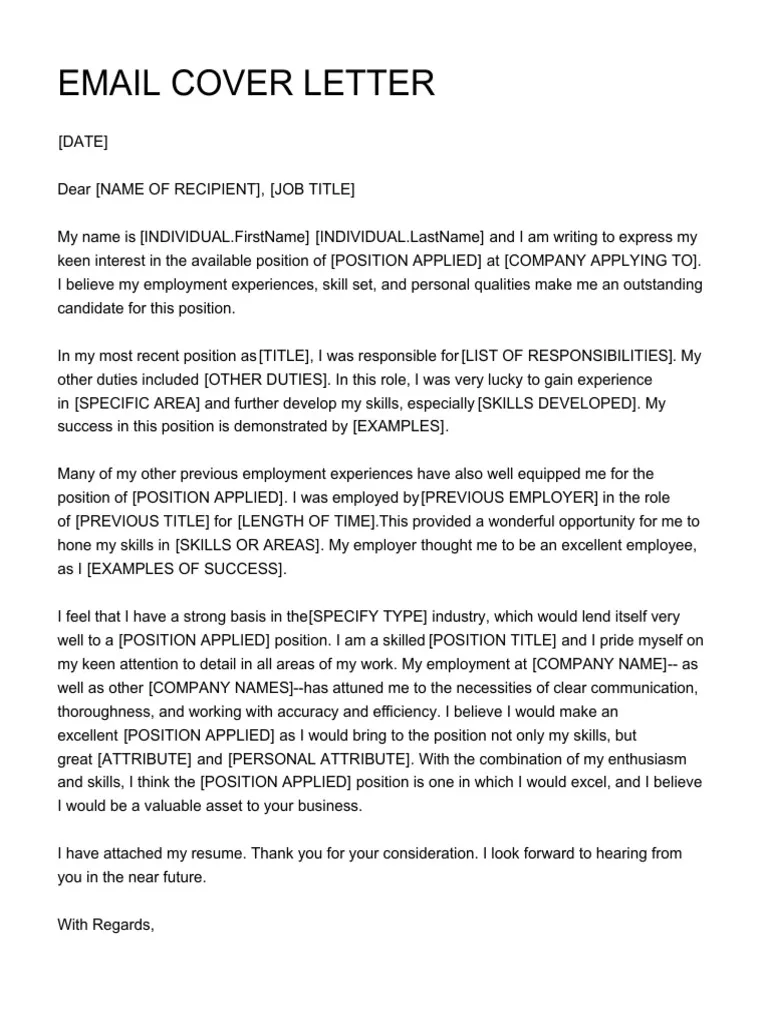
The subject line is your first chance to grab the hiring manager’s attention, and a great subject line will increase the likelihood of your email being opened. Keep it concise and informative. Include the job title and your name, and always mention the position you’re applying for. Avoid generic subject lines like ‘Job Application’. For example, use ‘Application for Marketing Manager - Your Name’. This helps the hiring manager quickly identify the email and the position you’re applying for. A well-crafted subject line will get the email opened, and that’s a win.
Email Body Structure
The email body should consist of three to four paragraphs, and each should serve a clear purpose. Start with a brief greeting, mention where you found the job posting, and state the position you’re applying for. In the second paragraph, highlight your key skills and experiences, and explain why you’re a good fit for the role. Provide concise examples to demonstrate your abilities. In the third paragraph, show your enthusiasm for the role and the company, and explain why you’re interested in the opportunity. The final paragraph should include a call to action and a thank-you. This structured approach ensures clarity and makes it easy for the hiring manager to understand your qualifications and interest in the role.
Closing and Sign-off
End your email with a professional closing, such as ‘Sincerely’ or ‘Best regards,’ followed by your full name. Double-check your contact information, including your phone number and email address, to ensure it’s accurate and up-to-date. Before sending the email, proofread it carefully for any grammatical errors or typos. Ensure that your email looks professional and reflects your attention to detail. A well-written closing with accurate contact information and a professional sign-off leaves a lasting positive impression and makes it easy for the hiring manager to contact you.
